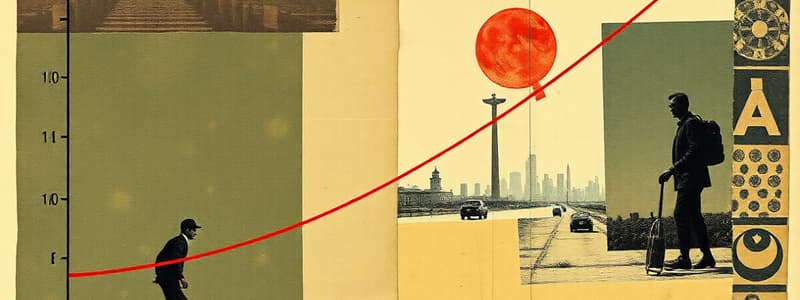Podcast
Questions and Answers
Quels facteurs peuvent influencer un décalage à droite de la courbe WS ?
Quels facteurs peuvent influencer un décalage à droite de la courbe WS ?
- Une hausse des charges fiscales sur les entreprises
- Une augmentation du taux de chômage
- Une augmentation de la qualité du travail (correct)
- Une diminution de la productivité du travail
Quel effet a un décalage à gauche de la courbe WS sur le salaire réel d'équilibre ?
Quel effet a un décalage à gauche de la courbe WS sur le salaire réel d'équilibre ?
- Il le laisse inchangé
- Il augmente le salaire réel d'équilibre
- Il le diminue (correct)
- Il ne change que si la courbe PS est décalée
Quel impact la dynamique des institutions du marché du travail a-t-elle sur la courbe WS ?
Quel impact la dynamique des institutions du marché du travail a-t-elle sur la courbe WS ?
- Elles ne modifient pas la courbe WS
- Elles peuvent entraîner un décalage à droite ou à gauche de la courbe WS (correct)
- Elles affectent seulement les salaires minimaux
- Elles influencent uniquement la courbe PS
Quelle est la relation entre la courbe WS et la courbe PS ?
Quelle est la relation entre la courbe WS et la courbe PS ?
Quelles modifications dans le cadre légal peuvent entraîner un décalage de la courbe WS ?
Quelles modifications dans le cadre légal peuvent entraîner un décalage de la courbe WS ?
Quel serait le résultat d'une hausse des salaires réels tout en maintenant une productivité constante ?
Quel serait le résultat d'une hausse des salaires réels tout en maintenant une productivité constante ?
Quel facteur pourrait provoquer une augmentation de l'offre de travail sur le marché ?
Quel facteur pourrait provoquer une augmentation de l'offre de travail sur le marché ?
Comment un décalage à droite de la courbe WS affecte-t-il l'emploi ?
Comment un décalage à droite de la courbe WS affecte-t-il l'emploi ?
Flashcards
WS Curve
WS Curve
The wage-setting curve, showing the relationship between real wage and employment.
Rightward Shift (WS)
Rightward Shift (WS)
An increase in real wage and/or productivity, causing firms to pay higher wages at all employment levels.
Leftward Shift (WS)
Leftward Shift (WS)
A decline in real wages and/or increase in unemployment, leading firms to offer lower wages.
Productivity Increase
Productivity Increase
Signup and view all the flashcards
Equilibrium Real Wage
Equilibrium Real Wage
Signup and view all the flashcards
Labour Market Institutions
Labour Market Institutions
Signup and view all the flashcards
PS Curve
PS Curve
Signup and view all the flashcards
Equilibrium Employment
Equilibrium Employment
Signup and view all the flashcards
Study Notes
Movements of the WS Curve
-
The WS curve, or wage-setting curve, represents the relationship between the real wage and the rate of employment.
-
It shows the wage rate firms are willing to pay at different levels of employment.
-
Several factors influence the position of the WS curve, including:
- Productivity
- Legal framework regulating work conditions, such as minimum wage laws
- The bargaining power of unions
- Labour market institutions
- Expectations about wages
- Perceived difficulty of hiring and firing workers
- Demographic factors
-
A shift in the WS curve will change the equilibrium levels of output and employment.
-
Rightward (upward) shift: An increase in real wages and/or productivity might cause a rightward (upward) shift. This would mean firms are willing to pay higher wages at any given level of employment.
-
Leftward (downward) shift: A decline in real wages and/or an increase in the unemployment rate might cause a leftward (downward) shift. This would mean that firms are only willing to pay lower wages at any given level of employment.
-
Factors influencing a rightward shift:
- Increased labour productivity.
- Positive changes in labour market institutions. This might involve increased bargaining power for employees or an improvement in relations between employers and employees.
- Improvements in labour quality.
-
Factors influencing a leftward shift:
- Reduced labour productivity.
- Changes in the labour market such as greater difficulty hiring and firing staff.
- Negative changes in labor market institutions
-
The curve is not static; its position changes over time due to the dynamics of the factors mentioned above. These shifts can be influenced by short-term and long-term economic factors.
-
Effect on the equilibrium real wage and employment:
- A rightward shift leads to a higher equilibrium real wage and higher employment.
- A leftward shift leads to a lower equilibrium real wage and lower employment.
-
Relationship with the PS curve: The WS curve interacts with the PS curve (price-setting curve) to determine the equilibrium real wage and employment level in the economy. The intersection of these two curves determines the short-run equilibrium for the economy.
-
Importance in macroeconomic analysis: The WS curve provides important insights into the relationship between real wages, employment, and inflation. Understanding its movement is crucial for macroeconomic policymakers aiming to maintain stable employment and price levels.
Studying That Suits You
Use AI to generate personalized quizzes and flashcards to suit your learning preferences.



